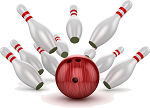Bowling, a timeless sport beloved by millions, has undergone a remarkable transformation over the years. From its humble beginnings in ancient civilizations to the high-tech lanes we see today, the evolution of bowling techniques and equipment has been nothing short of extraordinary. In this comprehensive 2000-word article, we will embark on a journey through time, exploring the differences between old school bowling techniques and the modern game we know today. We’ll delve into the equipment of each era, examine the scoring abilities, lane conditions, oil patterns, ball designs, and much more.
The Charm of Old School Bowling
Equipment of the Past: In the early days of bowling, the sport exuded a charming simplicity that contrasted sharply with the modern game we know today. Wooden balls, devoid of the finger holes that are now commonplace, were the primary tools of bowlers. These balls posed a unique challenge as they lacked the grip assistance afforded by their contemporary counterparts. With no finger holes to secure a firm hold, bowlers were required to finesse their shots with exceptional hand-eye coordination. Each roll down the lane became a delicate dance between the bowler’s fingers and the smooth, polished surface of the wooden sphere.
The absence of advanced equipment meant that control and precision were paramount in the early days of bowling. Bowlers honed their skills through countless hours of practice, relying on their innate ability to gauge the perfect release point and the ideal trajectory for each shot. The simplicity of wooden balls and basic pins left little room for error, making every strike a testament to the bowler’s mastery of technique. This era was defined by a deep connection between the bowler and the game itself, where success was measured not in high scores but in the satisfaction of a well-executed roll down the lane.
Scoring Abilities: Old school bowling introduced a unique scoring system that was entirely manual. Scores were meticulously calculated by hand, emphasizing accuracy and consistency in recording each player’s performance. In this era, each pin knocked down held profound significance, as even a minor error in scoring could substantially alter the outcome of a match. The responsibility of keeping accurate scorecards rested squarely on the shoulders of bowlers and scorekeepers, fostering an atmosphere of precision and vigilance throughout the game.
Manual scoring added an additional layer of challenge and engagement to the sport. Bowlers had to not only focus on their shots but also keep a watchful eye on their opponents’ performances, ensuring that every pinfall was correctly recorded. This meticulous approach to scoring not only highlighted the importance of accuracy but also underscored the sportsmanship inherent in the game. It encouraged bowlers to be not only skilled competitors but also honest arbiters of their own performance, creating a sense of integrity that still resonates within the bowling community today.
Lane Conditions and Oil Patterns: In the era of old school bowling, the lanes themselves were vastly different from the synthetic surfaces commonly found in modern bowling alleys. Wooden lanes, with their distinctive charm and character, were the norm. However, one of the challenges of bowling on wooden lanes was the significant variation in lane conditions from alley to alley. Each lane had its own idiosyncrasies, making it a unique battleground for bowlers. The natural wear and tear of wood over time meant that bowlers had to adapt continually, mastering the art of reading and adjusting to the quirks of the particular lanes they encountered.
Adding to the complexity, oil patterns in old school bowling were rudimentary at best. Unlike the carefully crafted and precisely measured oil patterns of modern lanes, these earlier iterations were often applied with a more straightforward approach. This lack of sophistication meant that bowlers had to rely heavily on their experience and adaptability. They learned to decipher the subtle hints provided by the oil on the lane and adjust their techniques accordingly. This adaptability was a hallmark of old school bowlers, as they navigated the intricate tapestry of wooden lanes and less predictable oil patterns with skill and finesse.
Ball Designs: In the early days of bowling, wooden balls took center stage as the primary bowling equipment. These balls came in varying sizes and weights, and each presented a unique challenge for bowlers. The absence of finger holes, which are now standard in modern bowling balls, meant that bowlers had to rely solely on their grip strength and the dexterity of their fingers to hold and control the ball. Wooden balls demanded a keen sense of touch and finesse, as even the slightest variation in release could drastically alter the ball’s trajectory.
Moreover, unlike the advanced bowling balls of today with their reactive resin coverstocks and weight blocks, the wooden balls of old school bowling were devoid of such features. The outcome of a roll depended entirely on the bowler’s technique, skill, and experience. Achieving consistent, accurate shots required an in-depth understanding of the ball’s behavior on the lane, as well as precise timing and control. Bowlers who could master the idiosyncrasies of wooden balls stood out not only for their athletic prowess but also for their profound knowledge of the sport’s fundamental principles. It was a time when the bowler’s technique was the ultimate differentiator, and achieving success in the lanes was a testament to their dedication and mastery of the game.
The Modern Bowling Revolution
Equipment of Today: Modern bowling has experienced a dramatic transformation, ushering in a technological revolution that has redefined the sport. At the forefront of this revolution are the bowling balls themselves. The introduction of reactive resin coverstocks has revolutionized the way bowlers engage with the lanes. These coverstocks offer enhanced grip and friction, enabling the ball to create a stronger and more predictable hook pattern down the lane. This breakthrough has given bowlers unprecedented control over their shots, allowing them to manipulate the ball’s trajectory with precision. The result is a game where power and accuracy merge seamlessly, unlocking new avenues for achieving high scores.
In addition to reactive resin coverstocks, modern bowling balls are equipped with finger holes that provide a secure and customizable grip. These holes allow bowlers to fine-tune their control over the ball, adding a layer of personalization to their game. Moreover, weight blocks, strategically placed within the ball’s core, enable bowlers to adjust the ball’s weight distribution to match their playing style and lane conditions. With a diverse array of ball options available, each designed for specific lane conditions and playing styles, modern bowlers are equipped with a toolbox of equipment to tackle any challenge the lanes present. This level of customization and technological advancement has not only elevated the sport but also created an environment where innovation is continually driving the boundaries of what is possible in the world of bowling.
Scoring Abilities: In the realm of modern bowling, technology has reshaped the way scores are recorded and communicated. Automated scoring systems have replaced the manual scorekeeping of old school bowling. These systems offer real-time feedback and provide bowlers with instant results, eliminating the need for manual calculations. This not only simplifies the scoring process but also adds an element of convenience and accuracy, allowing bowlers to focus more on their game and less on keeping track of their scores. The instant gratification of seeing your score displayed overhead after each frame enhances the overall experience, making it more accessible and enjoyable for both casual and competitive bowlers.
The advent of advanced technology has also led to a noticeable shift in the focus of modern bowlers. While precision and accuracy are still crucial, the emphasis has shifted towards power and striking ability. With the aid of high-performance bowling balls, reactive resin coverstocks, and refined techniques, modern bowlers consistently achieve high scores and pursue the coveted perfect game of 300. The quest for strikes has become a thrilling pursuit, with bowlers pushing their limits to maximize their scoring potential. The scoring environment has evolved to reward not only accuracy but also the ability to generate impressive pin action and maintain striking momentum, creating a dynamic and exciting atmosphere on the lanes.
Lane Conditions and Oil Patterns: Modern bowling alleys have embraced synthetic lanes as the standard, ushering in an era of unparalleled consistency and control. These synthetic lanes, meticulously engineered for uniformity, provide bowlers with a level playing field. Unlike the wooden lanes of the past, which could vary significantly from one alley to another, synthetic lanes offer a predictable and reliable surface for bowlers to hone their skills. The transition from wood to synthetic lanes has been a game-changer, ensuring that the lane conditions remain stable and allowing bowlers to focus more on their technique and strategy.
One of the defining features of modern bowling is the intricacy of oil patterns. These advanced oil patterns are designed with precision to challenge bowlers’ skills and strategies. Lane maintenance crews work diligently to apply oil patterns that can vary in length, volume, and distribution, creating unique challenges for bowlers. Lane management, which involves adapting to changing oil patterns and lane conditions, has become a pivotal factor in achieving success on the lanes. Modern bowlers must master the art of reading the lanes and making strategic adjustments to maximize their scoring potential. The synergy between advanced oil patterns and synthetic lanes has elevated the sport, demanding a higher level of skill, adaptability, and strategic thinking from today’s bowlers.
Ball Designs: The modern bowling ball is nothing short of a technological marvel. At the heart of this innovation is the reactive resin coverstock, a material designed to provide an exceptional grip on the lanes. Reactive resin coverstocks possess a unique ability to generate friction with the lane surface, enhancing the ball’s hook potential and creating a more dynamic and controllable motion down the lane. This increased grip enables bowlers to execute a wider range of shots, from powerful hooks to delicate spares, with remarkable precision.
In addition to the reactive resin coverstock, modern bowling balls are equipped with weight blocks—a critical component that allows for precise weight distribution. These weight blocks can be strategically placed within the core of the ball to achieve specific outcomes. Bowlers can customize their ball’s weight distribution to match their individual preferences and adapt to different lane conditions. This level of customization empowers bowlers to fine-tune their equipment to maximize their performance, creating a symbiotic relationship between the bowler and the ball. The synergy between reactive resin coverstocks and weight blocks has revolutionized the sport, giving bowlers the tools they need to conquer the intricacies of modern lane conditions and achieve higher scores.
Bridging the Gap: Old School Techniques in Modern Bowling
While modern bowling has brought with it a host of technological advancements, some old school techniques remain relevant. The importance of accuracy and precision, honed over years of wooden ball mastery, is still evident in the modern game. Bowlers who can consistently hit their mark have a distinct advantage in today’s competitive landscape.
Moreover, the experience of old school bowlers in adapting to varying lane conditions has proved invaluable in navigating the intricacies of modern oil patterns. The ability to read the lanes and make subtle adjustments remains a cornerstone of success.
Conclusion: The Everlasting Appeal of Bowling
Bowling, with its enduring appeal, serves as a unifying force that transcends generations and borders. It’s a sport that seamlessly weaves together elements of tradition and innovation, offering something for everyone within its broad spectrum. Those who cherish the nostalgic simplicity of wooden lanes and basic equipment find solace in the echoes of a bygone era, while those who embrace the marvels of modern technology revel in the high-stakes world of precision and power. In this harmonious blend of the old and the new, bowling becomes a timeless pastime that bridges the generational gap.
In the ever-evolving world of bowling, each bowler finds their unique path, whether rolling a wooden ball with precision or wielding a high-tech marvel with gusto. The beauty of this sport lies in its ability to connect individuals across the ages, fostering a sense of camaraderie and unity. It’s a reminder that while technology and techniques may change, the fundamental joy of knocking down those pins remains a constant, binding all bowlers in a shared love for the game. So, whether you’re a veteran of the wooden lanes or a newcomer to the world of reactive resin coverstocks, savor every moment on the lanes, for in bowling, the thrill of the game knows no boundaries and stands as a testament to the enduring allure of this cherished sport.
FAQs (Frequently Asked Questions)
Q1. What is the objective of bowling?
A1. Bowling is a sport where the objective is to knock down a set of ten pins arranged in a triangular formation at the end of a lane using a heavy ball.
Q2. How many chances does each player get per frame in a standard game of bowling?
A2. In a standard game of bowling, each player gets two chances or rolls per frame to knock down as many pins as possible.
Q3. What is the difference between old school and modern bowling techniques?
A3. Old school bowling relied on wooden balls, manual scoring, and basic lane conditions, while modern bowling features high-tech equipment, automated scoring, synthetic lanes, and advanced oil patterns.
Q4. What is the purpose of finger holes in bowling balls?
A4. Finger holes provide bowlers with a secure grip on the ball, allowing for greater control and precision when releasing the ball down the lane.
Q5. How are bowling lanes and oil patterns prepared for games?
A5. Bowling lanes are typically made of synthetic materials today, and oil patterns are meticulously applied to control lane conditions. The oil patterns vary in length and volume to challenge bowlers’ skills.
Q6. What is a perfect score in bowling, and how is it achieved?
A6. A perfect score in bowling is 300, achieved by knocking down all ten pins with strikes in all 12 frames of a game.
Q7. Can people of all ages and skill levels enjoy bowling?
A7. Absolutely! Bowling is a sport suitable for individuals of all ages and skill levels, making it a popular choice for family outings, social gatherings, and competitive leagues.
Q8. What are the different types of bowling balls available, and how do they differ?
A8. Bowling balls come in various types, including reactive resin, urethane, and plastic. Each type has unique characteristics that cater to different lane conditions and playing styles.
Q9. What role does lane management play in modern bowling?
A9. Lane management involves making adjustments to one’s approach and target based on lane conditions and oil patterns. It is a crucial skill in modern bowling to maximize scoring potential.
Q10. Is bowling a physically demanding sport?
A10. Bowling can be enjoyed by individuals with a range of physical abilities. While it doesn’t require intense physical exertion, it does demand skill, balance, and finesse, making it a sport accessible to a wide audience.















